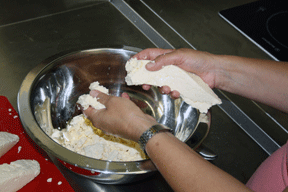This is a wonderful, traditional English cheese that I thoroughly enjoyed making.
Ingredients:
8 litres of milk
¼ teaspoon of Calcium Chloride diluted in ¼ cup un-chlorinated water. (This can be omitted if you are pasteurising your own milk)
2 drops of cheese colouring (optional)
1 dose Direct Inoculation Mesophilic Starter Culture
½ Rennet tablet or ½ teaspoon of liquid rennet dissolved in ¼ cup un-chlorinated water
2 Tablespoon Cheese salt
Equipment:
Large stainless steel pot;
A second, larger stainless steel pot ot put the first pot into to act as a double boiler;
Cheese thermometer;
Stainless steel knife fro cutting the curd;
Several 90cm square butter muslin for making cheeses;
Stainless Steal slotted spoon;
Large stainless steel of enamel colander;
cutting board
Cheese mould or basket and follower
Cheese press
Instructions:
Place your milk into a large stainless steel pot and then place this pot into your second larger pot with water in it to act as a double boiler. Add the Calcium Chloride solution and mix well. (The calcium chloride can be omitted if you are using farm fresh milk.
Heat your milk to 30 degrees C using indirect heat.
Add your culture, mixing in well, and let the milk rest undisturbed at 30 degrees C for 45 minutes.
Add your cheese colouring diluted in ¼ cup of non chlorinated water and mix in well.
Add your rennet solution to the milk stirring for one minute in a gentle up and down motion, being sure that the rennet is evenly distributed throughout the milk. Allow to set for 45 minutes, maintaining the temperature at 30 degrees C.
Check for a ‘clean brake’. If the curd is not firm enough leave or another 5 minutes and check again.
Once the curd is firm enough and gives a clean brake, cut the curd into 6mm centimetre cubes. Let set for 5 minutes.
Gently stir occasionally for a further 10 minutes.
Using indirect heat, gradually increase the temperature to 35 degrees C. This should take about 30 minutes. Continue to stir the curds gently to prevent them from matting together.
Maintain the temperature 35 degrees and stir for a further 30 minutes.
Pour the curds into a colander lined with your cloth and allow them to drain for 20 minutes.
Tip the drained curds out of your colander onto a cutting board. Cut the curds into strips about 4cm thick and lay the slices on a clean draining board, cover with a clean tea towel to drain. Turn the slices over every 20 minutes for one hour.
Place the slices into a bowl and gently break the curds up with your fingers into pieces about the size of a 5 cent piece. Using your hands, stir them for a few minutes and them add your salt and again using your hands mix the salt in.
Remove you cheese form the basket and carefully remove the cloth. It is important not to tear the surface of the cheese. Air-dry the cheese at room temperature on a wooden cheese board. This will take 3-5 days. Be sure to turn the cheese over every few hours so that moisture does not collect on the bottom of the cheese.
Wax or vacuum pack the cheese and age at 10 degrees C for 12-16 weeks.









Sounds like a good cheese, might give this a go on Thursday when I have some time up my sleeve.
ReplyDeleteThis looks really good. I like your cheese press!
ReplyDeleteSo simple,I might just have a go at that.
ReplyDelete